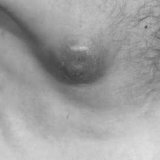Diseases of the mammary glands in men

Do not be surprised that men also have mammary glands, although the masculine mammary gland is called - breast, because it can not produce breast milk. In addition, in women the development of this tissue is under the influence of female sex hormones. In males, the amount of these hormones in the body is much less. As a result, the mammary gland in men is actually underdeveloped. But breasts can also be found in men, under which it increases.
Indications for mammograms in men:
- presence of compaction in the tissues of the breast;
- skin changes, areola and nipple;
- presence of contralateral breast cancer.
A standard mammography study for men includes mammography in two forms: craniocaudal - direct and mediolateral - oblique. In order to clarify the nature of changes in the mammary gland, additional sighting shots are used, as well as enlarged images.
Breast cancer in men
One of the breast diseases in men is breast cancer. It is a fairly rare disease. It occurs 100 times less than in women. It can be said that less than 1% of all cases of breast cancer are men.
Mammography studies help to separate gynecomastia and breast cancer from the specific location of the gynecomastia - on the nasal region, the symmetry of the structures, and the eccentric location of the tumor.
Sometimes you can find microcalcinates. Sonography allows in the separation diagnosis of cystic and solid formations. There are cases when intraprostitic and intra-cystic structures can not be distinguished from surrounding tissues.
It is generally accepted that in 30 to 70% of cases this disease in men develops due to gynecomastia, in particular its focal form. That is why a comprehensive examination of gynecomastia with the mandatory use of both clinical - examination, palpation, and X-ray methods of research leads to early recognition of cancer, which increases the success of treatment of mammary gland disease in men.
Gynecomastia
Gynecomastia is a benign enlargement of the mammary glands in men. In this case, the term "benign" is used, because the increase in mammary glands in a male of a malignant nature is already breast cancer.
Gynecomastia is seen as a visible or palpable increase in the mammary gland in men. The size of this increase can reach figures from 1 to 10 cm. It forms an average of 4 cm. Externally enlarged mammary gland with gynecomastia resembles a female breast of small size.
Gynecomastia basically regresses spontaneously and does not cause any very serious inconvenience to the man. True, with prolonged existence, this disease increases the risk of developing breast cancer. This disease occurs in men rather rarely, but often leads to the most serious consequences, as the breast cancer in the female.
The following symptoms are indicative of breast cancer: the discharge of blood from the nipple, the appearance of tight sealing, the skin changes over the formation, the appearance of ulceration, the enlargement of the lymph nodes under the mice.
Categories and forms of gynecomastia
There are 5 forms:
- physiological( juvenile, puberty and senile)
- endocrinological( with hypogonadism, testicular tumors, hypothyroidism, adrenal glands);
- is not endocrine;
- medication( with estrogen, testosterone and others.);
- is idiopathic.
It is believed that the development of gynecomastia is a consequence of the hormonal imbalance of 4 categories:
- of extra estrogens;
- androgen deficiency;
- androgen receptor defect;
- increased the sensitivity of the gland tissue to estrogens.
Gynecomastia can be a physiological or consequence of a major disease.
Among the remaining benign tumors, as well as tumor-like diseases in men, there are: fibroadenomas, abscesses, cysts, mastitis, syphilis, tuberculosis, intraprostatic papillomas and so on.



